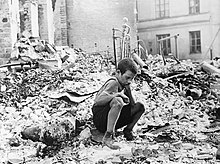
Quick Facts

Biography
Julien Hequembourg Bryan (23 May 1899 in Titusville, Pennsylvania – 20 October 1974) was an American photographer, filmmaker, and documentarian. He is best known for documenting the daily life in Poland, Soviet Union, and Nazi Germany between 1935 and 1939. He was honored with „Zasłużony dla Kultury Polskiej" ("Merit for Polish culture") during his last visit in Poland (1974) for showing the truth about the Invasion of Poland.
Before World War II
Bryan was a son of an elder in the Presbyterian Church with a long missionary tradition.
At seventeen after graduating from high school, he volunteered to serve American Field Service for the French Army in World War I, driving an ambulance in Verdun and the Argonne, and wrote a book Ambulance 464 about this experience illustrated by his photographs


He graduated from Princeton University in 1921 and finished Union Theological Seminary, though he chose not to be ordained as a minister. Afterwards he directed YMCA in Brooklyn, NY
At this time Bryan started traveling abroad taking photographs, making films and writing travelogues along the way. He funded his travels by giving slideshow lectures about countries he visited and by selling his films to various companies including ERPI. Many of the films from those travels can be found in United States Holocaust Memorial Museum's Steven Spielberg Film and Video Archive. Those human-interest movies chronicle travels through China, Caucasus and Georgia (1933), Soviet Union (1930 and 1935), Poland (1936), Germany (1937), Switzerland and the Netherlands (1939). His films and photographs from Nazi Germany chronicled party rallies, daily life on the streets, anti-Jewish propaganda and Nazi leaders. They were incorporated into two ’’March of Time’’ films. His slide lectures were held in concert halls including Carnegie Hall.
World War II
Bryan learned about the German invasion of Poland on September 3 while traveling by train to Warsaw. He arrived in Warsaw on September 7 carrying his Leica still camera, Bell & Howell movie camera and 6000 feet of film, just as all foreigners, diplomats and government official were fleeing the capital. He contacted mayor of Warsaw Stefan Starzynski who provided him with a car, guide and interpreter Stefan Radlinski and permit to travel and photograph across Warsaw. In two weeks between September 7 and September 21, he managed to take hundreds of still photographs and 5000 feet of motion picture film documenting the Siege of Warsaw and the terror bombing of the city by German Luftwaffe. He is credited as the only foreign journalist in Warsaw at that time. Through Polish Radio he also made an appeal to the American president Franklin Delano Roosevelt to help civilians targeted by enemy bombers. During his stay in Warsaw he lived in the abandoned Consulate of the United States. He left Warsaw on September 21 after Germans declared a cease-fire to allow citizens of neutral countries to depart by train through East Prussia. In Koenigsberg fearing confiscation of his material he decided to smuggle out his already developed films. He managed to hide some of his films in souvenir gas mask containers collected by fellow traveler from US, by one account he hid some movies by wrapping them around his torso.
After arriving in New York in the fall of 1939 Bryan published some of his photographs. Life magazine printed 15 of his images in the October 23 issue and Look Magazine published another 26 in the December 5 issue. Bryan produced in 1940 as a short documentary film Siege, released by RKO Radio Pictures. and wrote a book with the same title. The film was nominated for an Academy Award the following year for Best Short Subject, One-reel.
In 1940 Bryan was hired by the Office of the Coordinator of Inter-American Affairs (OCIAA) to make a series of 23 educational movies on Latin American culture and customs. Afterwards State Department hired him to create another five movies about US.
After World War II
Julien Bryan returned to Poland in 1946. As part of an official UNRRA delegation he revisited Gdańsk and Warsaw. His kodachrome footage of recently destroyed Gdańsk is probably the first post-war film shot in that city.
In 1958 he revisited Poland and published hundred of his 1939 photographs from Warsaw. Working with daily newspaper Express Wieczorny they launched a big campaign, with a page of the 1939 pictures in each issue, and the words: "Do you recognize yourself, your relatives, your house and street? The Express is helping American photographer Julien Bryan to find the heroes of his film from besieged Warsaw in 1939." Readers who recognized anything in his pictures were asked to come to the newspaper's offices with that information. That way he met and recorded stories of many people in his photographs. He wrote about his experiences in Warsaw: 1939 siege, 1959 Warsaw Revisited published in 1959 in Poland.
In 1945, Bryan started International Film Foundation (IFF) and for the remainder of his career he made short documentary films for the school market. Son Sam Bryan joined IFF in 1960. Bryan died in 1974, just two months after receiving a medal from the Polish government for his still photography. After his death IFF was operated by Sam. In 2003 Sam Bryan donated both his father's still and motion picture footage of wartime Europe to the United States Holocaust Memorial Museum. Many of his works are currently held by the Library of Congress and the United States Holocaust Memorial Museum's Steven Spielberg Film and Video Archive In 2006 Siege was named to the National Film Registry of the USA by the Librarian of Congress as "a unique, horrifying record of the dreadful brutality of war". It was also nominated for an Academy Award.
His World War II experiences in Warsaw were fictionalized in the 1978 film ... Gdziekolwiek jesteś Panie Prezydencie (Wherever you may be, Mr. President) by Andrzej Trzos-Rastawiecki. The role of unnamed "American journalist" based on Julien Bryan was portrayed by Jack Recknitz.
